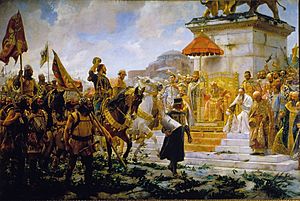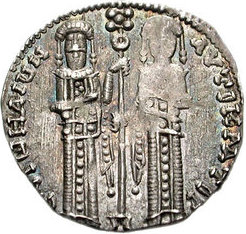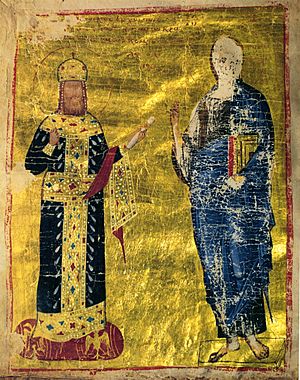Andronikos II Palaiologos facts for kids
Quick facts for kids Andronikos II Palaiologos |
|||||
|---|---|---|---|---|---|
| Emperor and Autocrat of the Romans | |||||

Miniature from the manuscript of George Pachymeres' Historia
|
|||||
| Byzantine emperor | |||||
| Reign | 11 December 1282 – 24 May 1328 |
||||
| Coronation | 8 November 1272 | ||||
| Predecessor | Michael VIII Palaiologos (alone) | ||||
| Successor | Andronikos III Palaiologos | ||||
| Co-emperor | Michael IX Palaiologos | ||||
| Proclamation | 1261 (as co-emperor) | ||||
| Born | 25 March 1259 Nicaea, Empire of Nicaea (now İznik, Bursa, Turkey) |
||||
| Died | 13 February 1332 (aged 72) Constantinople, Byzantine Empire (now Istanbul, Turkey) |
||||
| Spouse | Anna of Hungary Yolande of Montferrat |
||||
| Issue more... |
Michael IX Palaiologos Constantine Palaiologos John Palaiologos Theodore I, Marquis of Montferrat Demetrios Palaiologos Simonis (Simonida Nemanjić), Queen of Serbia Irene Palaiologina (wife of John II Doukas), Sebastokratorissa of Thessaly |
||||
|
|||||
| Dynasty | Palaiologos | ||||
| Father | Michael VIII Palaiologos | ||||
| Mother | Theodora Palaiologina | ||||
| Religion | Greek Orthodox | ||||
Andronikos II Palaiologos (Greek: Ἀνδρόνικος Δούκας Ἄγγελος Κομνηνὸς Παλαιολόγος, romanized: Andrónikos Doúkās Ángelos Komnēnós Palaiologos; born March 25, 1259 – died February 13, 1332) was a Byzantine emperor. He ruled the Byzantine Empire from 1282 to 1328. His time as emperor saw the start of the empire's final decline. During his reign, the Ottoman Turks took over most of Byzantium's lands in Anatolia. Andronikos spent his last years fighting his own grandson, Andronikos III Palaiologos, in a civil war. The war ended when Andronikos II was forced to step down in 1328. After this, he lived the rest of his life in a monastery.
Contents
The Life of Emperor Andronikos II
Andronikos was born on March 25, 1259, in Nicaea. He was the oldest son of Michael VIII Palaiologos and Theodora Palaiologina.
Becoming Emperor
Andronikos was named co-emperor in 1261. This happened after his father, Michael VIII, took back Constantinople from the Latin Empire. However, he was not officially crowned until November 8, 1272. While ruling with his father, he had to support an unpopular Church union with the Papacy. When Michael died in 1282, Andronikos became the sole emperor. He immediately ended the Church union. However, it took him until 1310 to fix the related split within the Orthodox Church.
Economic Challenges and Solutions
Andronikos II faced many money problems during his rule. The value of the Byzantine hyperpyron (a type of coin) dropped a lot. The government also collected much less money than before. To get more money and spend less, Andronikos II raised taxes. He also cut tax breaks and got rid of the Byzantine navy in 1285. This made the empire rely more on the powerful cities of Venice and Genoa.
In 1291, he rented 50 to 60 ships from Genoa. But without its own navy, Byzantium was weak. This became clear in two wars with Venice (1296–1302 and 1306–10). In 1320, he tried to rebuild the navy by building 20 ships, but he failed.
Diplomacy and Marriages
Andronikos II tried to solve some of the Byzantine Empire's problems through diplomacy. After his first wife, Anna of Hungary, died, he married Yolanda of Montferrat. This marriage ended Montferrat's claim to the Kingdom of Thessalonica.
He also tried to arrange a marriage for his son and co-emperor, Michael IX Palaiologos. The plan was for Michael to marry the Latin Empress Catherine I of Courtenay. This would stop Western groups from trying to bring back the Latin Empire. Another marriage helped avoid conflict with Serbia in Macedonia. Andronikos II married his five-year-old daughter Simonis to King Stefan Milutin in 1298.
Battles and Losses in Asia Minor
Even with peace in Europe, the Byzantine border in Asia Minor was falling apart. This happened despite some successful, but short, periods of rule by Alexios Philanthropenos and John Tarchaneiotes. Their victories against the Turks depended a lot on soldiers from Crete. These were Cretans who had escaped or were exiled from Venetian-controlled Crete. Michael VIII had brought them back to Byzantium in 1277. Andronikos II settled these Cretans near the Meander River, which was the southeastern border with the Turks.

After his co-emperor Michael IX failed to stop the Turkish advance in Asia Minor in 1302, the Byzantine government hired the Catalan Company. These were adventurers from Catalonia led by Roger de Flor. Their job was to clear Byzantine Asia Minor of enemies. They had some success, but their gains did not last. They were very harsh, even more so than the enemies they fought. They argued with Michael IX and eventually turned against their Byzantine employers after Roger de Flor was killed in 1305. With some Turks, they destroyed parts of Thrace, Macedonia, and Thessaly on their way to southern Greece. There, they took over the Duchy of Athens and Thebes.
Meanwhile, the Anatolian beyliks (Turkish states) kept taking Byzantine land. Prusa fell to the Ottoman Turks in 1326. By the end of Andronikos II's reign, much of Bithynia was controlled by Osman I and his son Orhan. Other Turkish groups also captured important cities like Paleokastron (after 1296), Simav (1328), Magnesia (1313), and Smyrna (1310).
Civil War and Abdication
The empire's problems were used by Theodore Svetoslav of Bulgaria. He defeated Michael IX and took much of northeastern Thrace around 1305–07. This conflict ended with another royal marriage. Michael IX's daughter Theodora married the Bulgarian emperor.
The wild behavior of Michael IX's son, Andronikos III Palaiologos, caused problems in the family. After Michael IX died in 1320, Andronikos II disowned his grandson. This led to a civil war that lasted until 1328. Bulgaria also got involved. Michael Asen III of Bulgaria tried to capture Andronikos II by pretending to send him military help. In 1328, Andronikos III entered Constantinople in victory. Andronikos II was forced to give up his throne.
Andronikos II died as a monk in Constantinople in 1332. He was buried in the Lips Monastery.
Money Matters and the Empire's Budget
The money problems during Andronikos II's reign made him take strong actions to cut government spending. He greatly reduced the native army, making it a very small force. Instead, he used foreign soldiers for hire and then local militias. These militias were not experienced, which made it hard to stop the Turkish advance.
For a while, the Byzantine navy was completely shut down. This made the empire depend on ships from Genoa and Venice, who charged very high prices. Many Byzantine sailors and shipbuilders who lost their jobs found work with the Turkomans. These Turkish groups had just reached the western Anatolian coast and wanted to build their own navies. These new fleets greatly increased the problem of Turkish pirates in the Aegean Sea. They attacked trade routes and coastal lands.
In 1320, because of higher taxes and stricter collection, Andronikos II managed to collect 1 million Hyperpyra for the year 1321. He planned to use this money to expand his army to about 3000 horsemen. He also wanted to rebuild the Byzantine Navy by building 20 ships. This plan was ambitious but still not enough for the empire's needs. It was stopped by the civil war with his grandson, Andronikos III.
For comparison, a Hyperpyron in 1320 was worth half as much as the older, stronger Nomisma coin from the time of Basil II.
Church Policies
When Andronikos ended the church union that his father had made, he also removed many of his father's church leaders. This included the pro-union Patriarch John XI. The new Patriarch, Joseph I, was against the union. He resigned and died the next year. A Cypriot named Gregory II replaced him.
Andronikos also faced the Arsenite Schism. This was a group that was against the union but did not agree with the emperor on much else. They were named after the former Patriarch Arsenios. He had been removed from office for excommunicating Michael VIII. Michael had blinded and imprisoned John IV. The Arsenites believed that the imprisoned John was the true Byzantine Emperor. They thought that Patriarchs John XI, Joseph I, and Gregory II were not legitimate.
To try and heal this split, Gregory called for a church meeting. He invited the Patriarchs of Alexandria and Antioch. He asked them to take back their earlier statements supporting the union. The Patriarch of Antioch refused. He then left his office and fled to Syria. Gregory also got Empress Theodora to publicly promise that she would never ask for her deceased husband Michael VIII to have a Christian burial. This meeting helped satisfy the Orthodox clergy, but it did not satisfy the Arsenites.
A few years later, Gregory II was forced to resign. Some of his writings were thought to be against church teachings. Andronikos chose a hermit from Mount Athos to replace him. This new Patriarch took the name Athanasius. He was very strict and simple in his life. He often criticized church leaders for having too many worldly possessions. He even tried to take property from some of the richer churches and monasteries. Many church leaders reacted with anger. They even threw stones at him when he walked in Constantinople. Athanasius stopped appearing in public without bodyguards.
In the summer of 1293, Andronikos returned from visiting his shrinking lands in Anatolia. He was met by a group of important church leaders who demanded that Athanasius be removed. Andronikos did not want to, but the strong opposition forced him to agree. Meanwhile, Athanasius wrote a church document himself. In it, he excommunicated the church leaders who had spoken against him. He hid it in a pillar in the northern gallery of Hagia Sophia. It was found only a few years later, causing a lot of trouble.
Andronikos II's Family
On November 8, 1272, Andronikos II married his first wife, Anna of Hungary. She was the daughter of Stephen V of Hungary. They had two sons:
- Michael IX Palaiologos (April 17, 1277 – October 12, 1320).
- Constantine Palaiologos, a high-ranking official called despotes (around 1278 – 1335). His nephew, Andronikos III Palaiologos, forced Constantine to become a monk.
Anna died in 1281. In 1284, Andronikos married Yolanda (renamed Irene). She was the daughter of William VII of Montferrat. They had several children:
- John Palaiologos (around 1286 – 1308), a despotes.
- Bartholomaios Palaiologos (born 1289), who died young.
- Theodore I, Marquis of Montferrat (1291–1338).
- Simonis Palaiologina (1294 – after 1336), who married King Stefan Milutin of Serbia.
- Theodora Palaiologina (born 1295), who died young.
- Demetrios Palaiologos (1297–1343), a despotēs.
- Isaakios Palaiologos (born 1299), who died young.
Andronikos II also had at least three daughters born outside of marriage:
- Irene, who first married Ghazan, Khan of Persia, and later John II Doukas, ruler of Thessaly.
- Maria, who married Toqta, Khan of the Golden Horde.
- A daughter known as Despina Khatun, who married Öljaitü, Khan of the Ilkhanate.
Foundations
- Ardenica Monastery
- Panagia Olympiotissa Monastery
- Zograf monastery
See Also
 In Spanish: Andrónico II Paleólogo para niños
In Spanish: Andrónico II Paleólogo para niños




